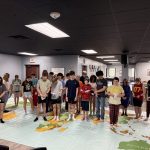I (Doug) have been at this missions thing now for over 40 years (43 years in October, in fact). During that time, unreached people groups have been a driving motive for my life. At various points during the 4 decades, the some advocate for “cities” voiced an opinion that we should “ditch people groups; care about cities,” I would bristle. To me, it always felt like “throwing the baby out with the bath water” — because we HAVE to approach cities with “people group eyes.” Why? Because in many cities, unreached people of various languages/ethnicities create huge pockets — like Chinatown, “little Mogadishu,” and “Dearborns.” So I’ve been convinced – we have to keep holding people groups in our mind as we evaluate urbanization for the future.
But finally, an author, researcher, and good friend has managed to tie up those loose ends for me – at least somewhat. Justin Long’s essay, “Urbanization And Measuring The Remaining Task,” at https://www.justinlong.org/essays/urbanization-and-measuring-the-remaining-task helped clarify several principles in my mind. Perhaps the clearest principle of all is simply this: We have to KEEP thinking about unreached peoples… and finish the task by mobilizing numbers that are in keeping with the sizes of the tribes. But at the same time, we no longer can afford the luxury of ignoring the “593 majority non-Christian megacities” if we’re going to finish TRULY the task of world evangelism – the mandate of the Great Commission.
What’s your take on Justin’s piece? Are you in agreement? If you’re NOT, wow. (How could anyone disagree, right? : ) ) But seriously, now — what do we DO about this piece? Justin’s a researcher. But good mobilization sometimes flows from good research. : ) Your thoughts?













Justin Long’s article is very interesting, easy to read, makes an excellent point in balancing kingdom efforts. Seems like the first step is to inventory the UPGs in each of cities, then plan the strategy to reach them. Has Joshua Project or some other organization already begun?
Some thoughts below.
Some valid points, yet we also need to track and consider the impact on the still totally unchurched towns and villages–and on the somewhat churched cities–not just the usually far more churched MegaCities.
A UUPG of 500 people who has local gospel access through a trade language they all speak is more reached than a town of 5000 people with no local gospel access and where urbanization drives a one way flow to urban areas, not back to rural areas–even if the urban areas are engaged.
A city of 10 million with hundreds or thousands of churches and hundreds of missionaries may still be majority non-Christian, but they have more meaningful gospel access than the rural town of 10,000 with no church and 0 to 1 Christians. The fact they’ve not spread or embraced the gospel access they have to the fullest extent possible in the MegaCity doesn’t change the fact that they have FAR more access to the gospel than most in an unengaged unchurched town or village. Yet, urbanization tends to cause the unchurched rural area’s needs to be more and more neglected simply because a given one doesn’t have impressive numbers. Add all of them together in a given country and you have the population of a huge MegaCity in some cases. yet, they remain with no workers.
Also, the churches in the large cities that are even majority non-Christian have the bulk of the responsibility to reach the rest of their city.
Urban focus in some countries has meant that the neglected 10/40 window of some countries is its rural areas. If foreign missionaries all go mainly, only, or dispropotionately to the churched MegaCities just because they are not majority Christian yet, it not only results in neglect of UPGs and of unchurched rural small cities, towns, and villages, but it also could usurp the role and thwart the development of the church already present in the MegaCities in reaching the rest in those respective city. To build on the analogy in the article, I don’t think the answer to not enough workers to cover a whole nation’s remaining areas of need is to put all the foreign workers in the areas where the national church is far stronger than anywhere else in a country or in a people group–which is usually the MegaCities. If a given MegaCity is 2% Christian, but the same country’s towns have only 0.01% Christian, the latter will not be reached by all the missionaries going to that MegaCity–nor by further increasing the number going to that MegaCity. The church already in the Mega Cities needs to reach its own as much as possible, and both foreign missionaries and the national church in the MegaCities need to be reaching out to address the gaps in the areas still with no church.
Over-concentration of resources in some areas deprives the rest from ANY resources at all. God commanded Adam and Eve, the post-flood world’s people, and Christians going to make disciples to spread out and fill the earth, not all stay in Jerusalem or to concentrate all the resources in Babylon. I only know the data in detail for one or two nations and have discussed it enough to have a pretty good idea for a third nation. So may sample size is small. But in those 3 cases at least, the MegaCities have far more churches already from which the gospel can further spread within those cities and far more missionaries than many of the rural areas–and that is true even on a per capita basis. So, yes, if you are trying to decide whether to send a worker to one MegaCity or another, knowing the % of believers in each would be helpful, but if you have 500 missionaries and a few thousand churches in Mega City X in a country where half the municipalities don’t yet have one church, I don’t think MORE focus on MegaCities is needed. People in majority churched areas of the US often say–why send missionaries overseas when we have so many needs here–having no idea how much more access to the gospel they have and how little they need missionaries compared to elsewhere. Perhaps there are some in parts of the world, but I can’t think of any MegaCity I am aware of that doesn’t have far more internal Christian resources–whether total or on a per capita basis–than other areas. Send more workers if necessary to mobilize those internal resources to reach their own and to mobilize them to send workers to the unchurched and underchurched, but even if they are majority non-Christian, they still have the majority of Christendom’s believers in most cases that I am aware of.
That said, I would agree that prioritizing every UUPG of 200 people in a MegaCity with majority non-Christian and where only 1 in 200 or 1 in 300 are believers and where the UUPG do have gospel access via a trade language would not always be warranted.
As for under-concentration, there is a point at which resources are spread too thin to reach the minimal essential level to reach critical mass perhaps–but that number is quite low, and it is hard to imagine many MegaCities in the world that are not over that threshold. Once that is reached, it must be kept in mind that every person sent to a place with many resources is one less who can go to a place with none. Of course, a higher number of workers might be ideal to optimize the rate of gospel expansion, but not until everywhere reaches the minimal threshold. Can anywhere always use more workers? Yes. Can over-concentrating those workers in MegaCities keep the rest of the world from ever getting any sustained local gospel access (church)? Most definitely. Not saying some are not needed in Mega Cities (though arguably not nearly as many as end up in some of them perhaps), but I am suggesting the need to spread out workers more evenly rather than concentrating them in a few MegaCities and thereby depriving the towns and villages of any is not what I view as something to pursue.
Is there a point at which a UUPG inside a Mega City or an unchurched village in a rural area s too small to be a priority relative to concentrating more workers in an under-resourced MegaCity/–I suppose in theory, albeit rarely so. But until the average per capita in such areas at least comes up to that of the majority people group in these MegaCities, I think the answer is no. Once it does? Yes, at that point, knowing which MegaCities are more under-resourced than others would be strategic in going beyond irreducible minimal up to optimal resource level. of course, many MegaCities are already above even that level, but probably not all. Yet, even in the small subset of MegaCities that are between the irreducible minimal and optional human resource levels, I’m guessing the small, mid-, and some large but not quite MegaCities would be next in line priority-wise on a per capita basis, for example.
I also suspect in many places–and I know in the case of one large UPG–that urbanization is actually largely preventing flow of the gospel from urban to rural areas, while disproportionately concentrating national Christians in the urban areas as well. This just widens the gospel access gap further between the unengaged unchurched rural areas and the churched highly engaged MegaCities. A new effort to more highly emphasize those MegaCities could condemn 1-2 more generations or more of rural people to never having meaningful gospel access in some places. So, while I don’t know if or for what purposes MegaCities need to be better tracked, I do know that they should not be considered in a vacuum without considering the impact of overconcentrating resources almost solely in MegaCities.
Is it not time to spread out and disperse from Babylon to fill the earth? Again, needs in both. But I do not believe urbanization justifies further increasing the overwhelming imbalance in Christian resources in MegaCities relative to elsewhere.
I also wonder if the issues through which many MegaCities are becoming less Christanized than they once were is due to urbanization and how much is due to liberal churches, neglect of the urban poor, suburbanization, and failure to pass faith to the next generation or prepare them to retain their faith when encountering the strength of the secular world view in certain MegaCities. If so, the issue is not one of insufficient resources, but how the resources there are being used.
And even if there is an actual shortage in human resources in a subset majority non-Christian MegaCities compared to what it is in majority Christian MegaCities, suburbs, cities, and some towns, I’d be surprised if most MegaCities do not still have more internal Christian resources than the average city, town, or village within their region. Under-concentration of resources can make it hard to achieve critical mass. There are certainly towns and villages and smaller cities where that is an issue. and while there may be MegaCities that could progress faster with more resources, I am not aware of any personally that doesn’t have a minimal necessary level, which cannot be said of unchurched areas. And even mid-sized cities surrounding such MegaCities likely are more under-resourced than the MegaCity in their region. Perhaps I’m wrong, and that is true only in Japan, but I’ve heard similar things about China. And even in the US, if you count the suburbs around Megacities as all part of that MegaCity vs. as separate areas, it would surely be true also in the US. Not sure about the rest of the world.
On a totally different note, UPGs in cities can be over focussed on. A UPG in its native lands, a UPG that is diaspora but strategic to reach as a means to reach that same UPGin its native lands, and a UPG in a MegaCity outside its native lands and not particualrly strategic in reaching that UPG in its original lands are three very different situations and should not be lumped together as if they are the same. ANY Mega-City will have members of many UPGs. O the other hand, in a sense, many of them are more third culture. Outreach to the diaspera is important. But, not every group from a UPG needs a separate outreach in every city where they exist no matter how few. If it is strategic to reaching back into the main population of that UPG, great. If not, it should be seen as that city’s Samaria and still reached out to with cross-cultural sensitivity, but really should not be considered in the same light as an unengaged UPG in its native abode. A UPG outside its native abode in a MegaCity is more like an unchurched village than an unreached Peoples. But let’s say in that MegaCity, there were 40,000 from UPGx in a city of 10 million that had 1 church per 20,,000 people. Then, that group would warrant prioritization of resources til it had 2 churches, but not til it had 10. Let’s say there were 8,000 in such a UPG but zero churches? Probably warrants prioritization til it has 1, but not 2. let’s say there is only 1 believer per 30 people in the Mega City, but that is 1 in 1000 in some neighborhoods and 1 in 2 in others within the megacity. The UUPG of 8000 probably warrants priority until there is at least 8 believers in it. That would bring it on par to the LEAST reached neighborhood of the main people group in that MegaCity. Of course, that probably means one needs to bring it up to maybe 20 or 30 people so it is more likely to continue in perpetuity and spread within that UPG. But at that point, arguably, the lesser reached neighborhoods of the MegaCity would warrant equal or more priority.
On yet another topic, though, if five MegaCities have 5%, 3%, 1%, and 0.1% Christians, knowing and tracking that would definitely be helpful to see that at least the 0.1% needs extra hands, and perhaps the 1% one needs some niche roles mainly but some extra hands at times perhaps. the issue in the 3% or 5% groups is likely something other than just being short-handed, nor is it likely due to urbanization alone–nominalism, not understanding their role in or else how to share the gospel, not knowing how to address the issues secularism has brought, or whatever likely are behind such stats in many cases. Some specialist niche needs may very well exist as a result, but sending more pioneer teams to such areas is probably not the solution. First, the real problem needs to be diagnosed.
Any area with more churches, more churches per capita, a higher % Christians, or even a single church has more resources than somewhere. Every area with at least one church has a starting point to reach the rest of that city/area. There is an irreducible minimum of resources perhaps for reaching a given area. Once that is reached, one has a responsibility to consider areas with less resources even if one’s more-resourced area could still benefit from additional resources. I believe if each part of the body of Christ consistently considered how its actions would impact the other parts–and the areas where no part yet exists–there would already likely be no place left without sustained local gospel witness. The irreducible minimum of course may be one to a few workers for a small town and more for a large city, but I don’t know of hardly anywhere no matter how reached or churched it is where believers don’t see the potential if there were more people resources. Until Jesus returns that will likely be the case. So, unless the needs of the less resourced areas concern those in the more resourced areas, an imbalance in distribution will continue to exist. And generally speaking, the imbalance favors the MegaCities, leaving the others short-handed. And while there are places and times the gospel may flow from urban areas to the rest of a nation’s municipalities within a given people group, there are an increasing number of places and times that that flow does not meaningfully exist. And urbanization is just further contributing to that reality.
Many municipalities within a country are in practical ways separate ponds, and more stones thrown into the Mega City pond–no matter how many–will create ripples in those separate ponds. If all the stones are shipped only to those Mega Cities, the other ponds will remain without ripples.
So, a blind over-focus on UPGs and UUPGs is not ideal, but neither is over-concentration of resources in urban centers when many rural areas suffer from massive under-concentration. I think most Mega Cities, even majority non-Christian ones, do not need more total missionaries, though they may need more of certain specialty niche missionaries and the same or perhaps in some cases far less of other kinds. The MegaCities need aid to increase the yield of fish in some cases, but it should not occur at the expense of the subset of non-MegaCities, that don’t yet even have a fishing pole. The needs should not be viewed in a vacuum.
Typo correction. The next to last paragraph in the comment above should have a not in it. It should read, “Many municipalities within a country are in practical ways separate ponds, and more stones thrown into the Mega City pond–no matter how many–will not create ripples in those separate ponds. If all the stones are shipped only to those mega Cities, the other ponds will remain without ripples.
There are over 44,000 urban locations on the planet. 40,000 of them have a population of less than 100,000. These locations are neither urban nor rural but what I term “rurban.”
The smaller the urban location generally speaking in the western world and especially in the US the more Christians and churches one will find there. However, this is the exact opposite in India and I suspect other Asian countries. Secondly these smaller locations are often overlooked in missionary circles perhaps due to their remoteness, lack of amenities or attraction. Nevertheless, they are strategic. See my article that wrote to the Global Leadership of YWAM back in the early 2000.’s titled “Don’t think big – think small.”https://www.ywamsanfrancisco.org/think-small These smaller locations need the attention of indigenous missionaries in particular.
Also you can find UPG information on some cities at https://www.ywamcity.org/recources Full data sets are available upon request for the locations listed there.
Sorry,
The link to the article on Don’t think big, think small is https://www.ywamsanfrancisco.org/think-small
There are also two other articles to YWAM on cities here: Multiplication through Simplicity: https://www.ywamsanfrancisco.org/multiplication-through-simplicity
and
The Unreached at our Doorstep: https://www.ywamsanfrancisco.org/the-unreached-at-our-doorstep